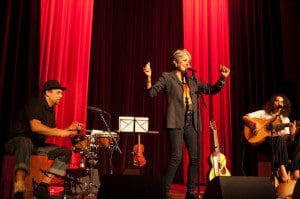
As diverse as the music performed in concerts is, so are the appearances of the audiences. James Mollison documented a spectrum of what he calls the “tribes” of attendees in his photography project and book The Disciples, a rough census of personae that converge around the archetypes represented by the musical acts Mollison followed. The grouped images of said disciples invite one to guess, before reading the captions, which performers each had come out for. It’s not hard: men in trucker hats and denim overalls, Merle Haggard. Men holding up sagging jeans by the crotch and women whose skirts barely reached their own, P Diddy. Union Jack mini-dresses, leopard print and afros? Spice Girls. Cinched lumberjack shirts, curly blonde wigs and feathery cowboy hats? Dolly Parton, obviously. Kiss makeup? You got it.
Recently at Yoshi’s in San Francisco, Joan Baez performed as a guest rather than as the main act, but the audience distinctly appeared to be of the Baez tribe. The restaurant side of Yoshi’s seemed to be patronized by slick young things coifed, Spanxed, and pressed into coy “my-eyes-are-up-here-jerk” cocktail attire. But inside the jazz club, the tone was far less bothered. The patrons were older, their dress casual and accented by the occasional ethnic jewelry piece. The shoes were decidedly comfort-oriented, the hair natural in color and texture, the makeup minimal on gracefully senescent faces. Sure, they could have been there for the comparatively unknown headliner from Montpellier, France, Marianne Aya Omac, but it seemed more likely that these were the people (or a small portion of them) who for the past five decades have been following Baez, rapt by her ever-burnishing voice, loving the ground whereon she stands.
And the voice is still beautiful, though time has humanized it. The young Joan Baez, like only a handful of other singers—Alfred Deller, Mahalia Jackson, Edith Piaf, Yma Sumac—had an instrument that rendered words like “talented” and “gifted” inadequate and made comparisons with other singers cruelly unfair. The pure, high soprano that evokes youth without sounding childish, the rapid, true vibrato, and the restraint of her phrasing (how she gives over just enough emotion to tell the story but no more, and makes so many other singers seem like hopeless hams. Just listen to “Wagoner’s Lad.” Listen, and perish.): all of this placed her in a class of her own. Her voice has changed, the fair-pretty-maiden tone deepened into that of a wise, soulful priestess. Her breath control now doesn’t support the show-stopping long notes featured in such early songs as “Fare Thee Well (10,000 miles)” or “Cucurucucu, Paloma.” Her voice fades out or breaks, and seems limited to pianissimo (she never was a belter) and thus some nuance in her storytelling is lost, too. But the voice that is there, while it is there, is still capable of holding an audience in thrall, as is her stage presence, which is dignified yet playful and witty. She is still the “barefoot Madonna,” and dances at the mike in her skinny jeans and smart blazer, her silver hair gleaming like a nimbus under the stage lights. She pokes fun at herself, at the hardy myths of her celebrity (like the exaggerated, if not entirely fabricated rumors of her past drug use), and makes the obligatory Dylan reference.
Few Baez songs, including those she wrote herself, evince such dramatic power as the broadside and the Child ballads of her early albums. If there is something to regret about Baez’s career, it might be that she has spent so much of it collaborating with artists of lesser talent, lending her unforgettable voice to their forgettable songs, sharing the stage out of what can only be regarded as an epically huge sense of generosity, a grandiose selflessness. The present partnership with Omac might not be a symptom of this element to the Baez persona, which her fans have chafed against for decades. While the evening got off to a slow start with what sounded like Christian (or perhaps merely generically spiritual) lite-rock, sung with closed-eyed earnestness by a Washingtonian in dreadlocks and hiking boots named Shimshai, soon Omac got people shaking their shoulders and even hollering the occasional “Olé!” from their seats. (It helped that she gave us a lesson in how and when and why to holler “Olé!” in the first place). A French singer with a background in Gypsy and gospel music, Omac’s voice recalls the kind popular in traditional Spanish music, one characterized by a huskiness that makes it sounds as if she’s spent her life having noisy arguments and noisier orgasms, but containing a powerful, rapid-fire vibrato and capable of trumpet mimicry, an impressive party-trick talent. Her voice, rough and guttural, melded with Baez’s more polished one to heartbreaking effect on “La Llorona,” “Cucurucucu,” and “Duele.” When Baez left the stage, the material succumbed to earnestness under a song of Omac’s composition–something about “make peace with your sacred parts”– but considering her penchant for penning new gospel music (and teaching French people to sing it!) one supposes it couldn’t be helped. It was less interesting musically than the Spanish pieces, but Omac’s self-deprecating and funny personality, and the occasionally astonishing vocal acrobatics that suggested she possessed so much more than she was revealing to us, kept the performance alive.
For new fans of Omac, and certainly for those of us for whom Baez is and will ever be the flow’r of them all, the concert was too short. It took considerable effort on the part of management to pry some of the more ardent fans away from the stage, even with the promise of free re-admission to the evening’s second performance. If Yoshi’s can deliver like that regularly, we might stuff ourselves into a cocktail dress and hang out there more often.
Read more from Larissa Archer at her blog, larissaarcher.com.

One thought on “The Staying Power of Joan Baez: Marianne Aya Omac at Yoshi’s in San Francisco”